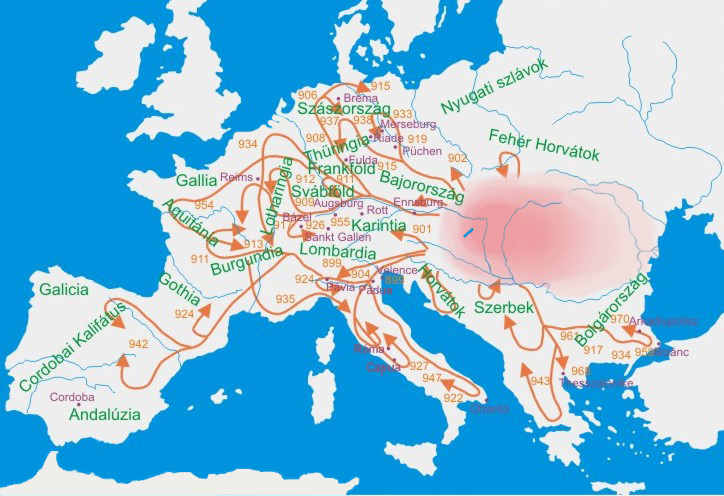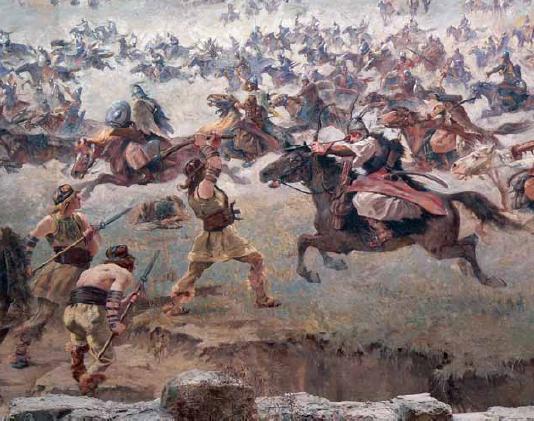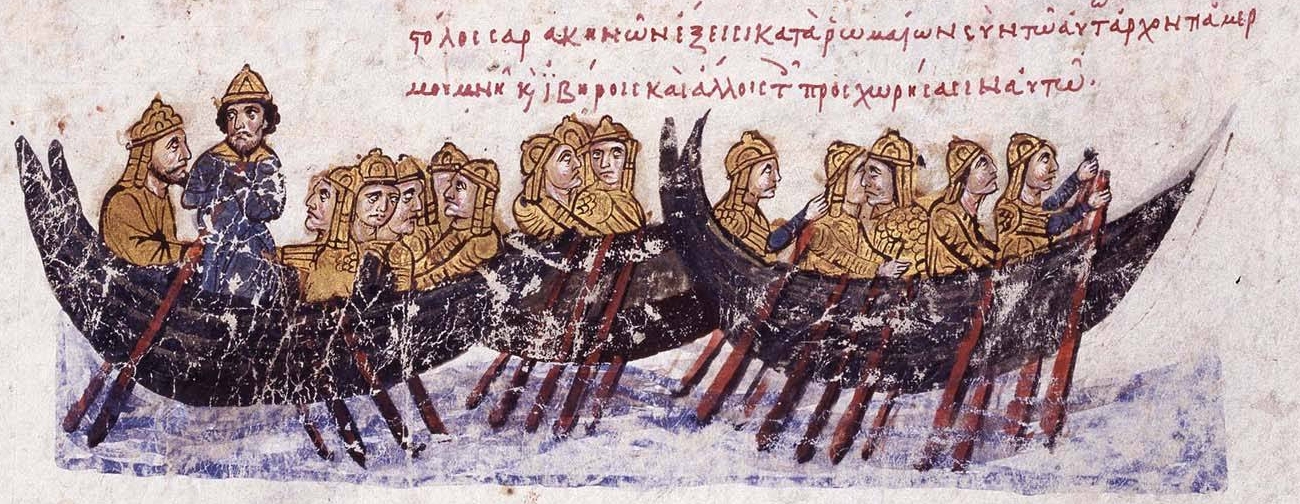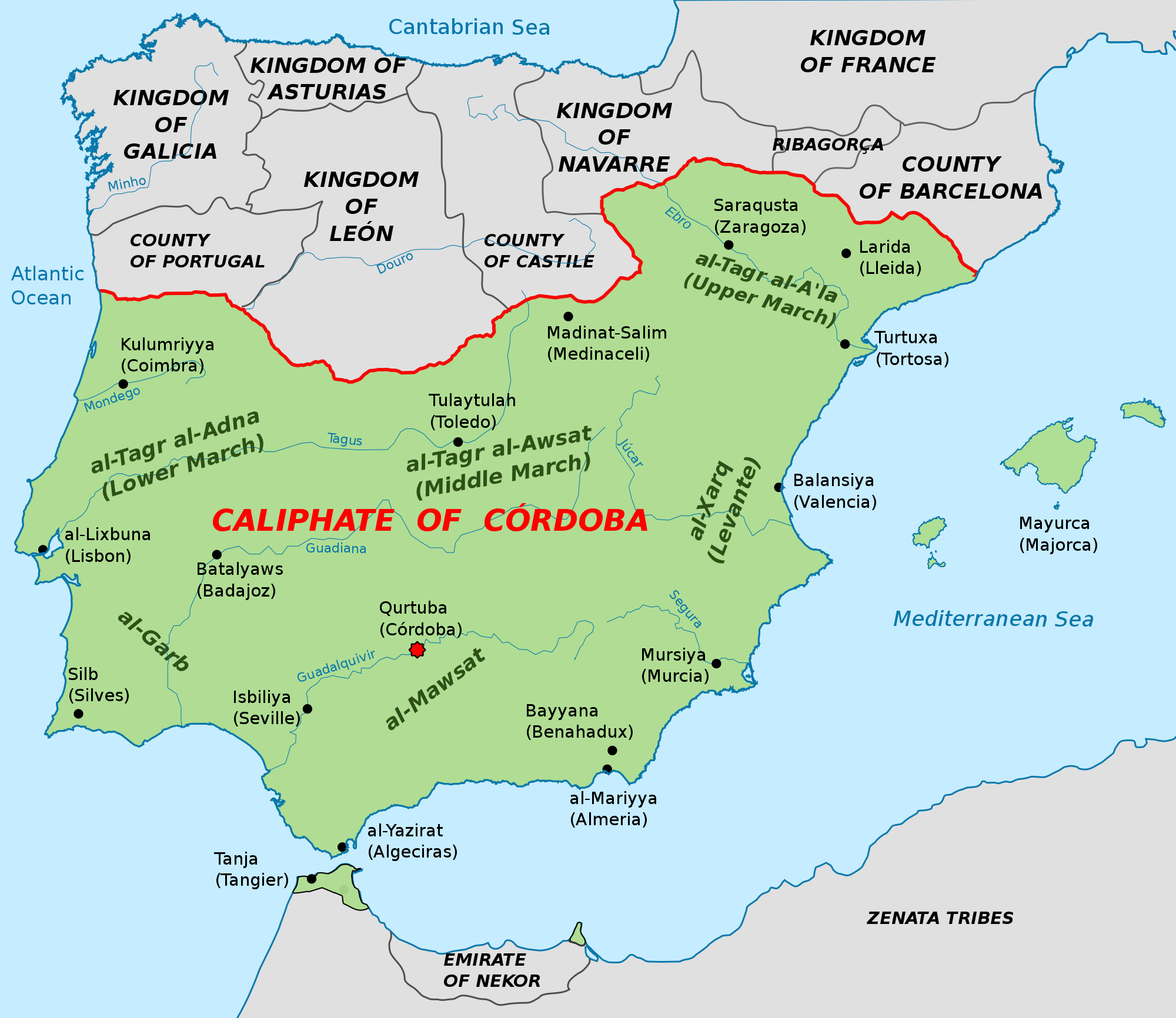1. HOW WAS MEDIEVAL SOCIETY ORGANISED.
After the collapse of the Carolingian Empire a new social system appeared: the feudalism.The feudalism was a social system of medieval Europe in which the nobility received land from the monarch in exchange for military service and loyalty.
1. 1. A period of inestability.
In the 9th and 10th centuries Western Europe suffered a series of invasions from several directions:- From the North: Normans (Vikings).
- From the East: the Hungarians.
- From the South: the Muslims.
- Only the nobles were able to maintain armies or built fortress and many free people ask them for protection. The ones who could afford military equipment became knights and the peasants became serfs
- The monarchs relied on the nobles for military support.
1. 2. Vassalage.
Vassalage (in spanish vasallaje) was a pledge of allegiance established in a dual ceremony:- The homage (in spanish, homenaje), in which the vassal, knelt before the lord and promised to be loyal and provide him with military and ecomic help.
- The investiture (in spanish, investidura), in which the king gave a fieddom (in spanish, feudo) to a vassal.
1. 3. A stratified society.
Feudal society was inequal and divided in estates (in spanish, estamento): closed social groups in which people were born and remained for life. There were two privileged estates and one non-privileged:- Privilieged estates: the nobility and the clergy. They were a small percentage of the population but:
- owned most of the land.
- did not pay taxes.
- held the kingdom's highest offices.
- Non privileged estate: peasants and artisans. They were most of the population:
- were forced to work for the other two estates.
- had to pay taxes.
- had no rights.
 |
| Vikings raids in Europe. File:Viking_Expansion.svg User:Max_Naylor |
 |
| Magyar's (hungarian) raids in Europe. File:Kalandozasok.jpg https://hu.wikipedia.org/wiki/Szerkeszt%C5%91:Csan%C3%A1dy CC BY-SA 3.0 |
 |
| Hungarians (Magyars) raids. The Magyars were a nomadic people of asian origin that settled in the Panonian plain and started to attack Eastern and Central Europe. |
 |
| Saracen boats. The saracens were muslims pirates that attacked the coasts of southern Europe. |
The vikings' attacks were brutal because they wanted to crush resistance by spreading terror among their victims. Also, they were pagans and had no problems to attack the symbols of the Christian religion or the members of the clergy.
The history of vikings in 5 minutes.
EXTRA. NORSE RELIGION AND MITHOLOGY.
The vikings came from the Scandinavian Peninsula (modern day Norway, Sweeden and Denmark) and they followed a polytheistic religion, with dozens of gods and mythical creatures such as the giants and the elfs. Among the most important gods were:
- Odin, king of the gods.
- Thor, god of thunder.
- Frey, god of agriculture.
- Freya, goddess of beauty and love.
- Loky, gof of mischief.
The Scandinavian peoples believed that the Universe was organized around a sacred tree, Ygdrassyl, and divided in nine kingdoms, among them Asgard, the kingdom of the Gods and Midgard, the kingdom of humanity.
The vikings believed that only the warriors that died in combat had the right to enter in the paradise (Valhalla). The rest of the poeple would go to Hellheim.
How Thor got his hammer.
Ted-Ed: Thor's journey to the land of the giants.
Ted Ed: Loki and the master builder.
Unraveling History: Loki. The video is in spanish, you have to select the english subtitles.
 |
| Homage, a member of the nobility promise to be loyal to he king. |
 |
| Bishop's investiture. The king gives a fiefdom to his vassal (the bishop). |
2. The feudal monarchy.
The king was considered to be sacred and chosen by God to rule:
- His office was hereditary.
- His power was validate by the Church in a coronation ceremony.
- The kingdom were his personal property and he was free to divide it.
2. 2. The king powers.
He had exclusive powers:- military: led military campaigns.
- economic: collect taxes.
- judicial: supreme judge.
He received help in matter of government from:
- The Royal council (Curia), composed of bishops, abbots, dukes, count and marquis.
- Civil servants who write royal documents and oversee the royal arvhives.
2. 3. Kings and kingdoms.
After the breakup of Charlemagne's empire, Europe was divided in several kingdoms with two common atributes:- christianity.
- feudal organisation.
- The Pope, who provide spiritual authority.
- The Emperor of the Holy Roman Empire. In the 10th century, the Pope crowned Otto I of Germany as emperor, but the title of emperor became an honorary title.
3. The privileged: the nobility.
The nobility were a privileged social group, whose role was to military protect society. Was composed of dukes, marquis, counts and barons. Their power came frome the lands they possesed, the fiefdoms, which enabled them to live in large castles and buy horses and weapons.
Their main activities of the noblemen were:
Their main activities of the noblemen were:
- training for battle, taking parts in joust and tournaments.
- in case of war, fight for the king.
- Hunting on horseback (wild boar, deer and foxes)
- falconry, to train a bird of prey to hunt.
- take responsability of servants and domestic matters.
- play music and to do embroidery.
- ride horses and hunt.
Castles.
Nobles lived in fortified castles. A castle was a military stronghold that symbolised the power of nobility. Its main characteristics were:- were located on high ground in a fiefdom.
- had very high and wide walls.
- contained several buildings around a courtyard.
- was self-sufficient with a wells, granaries and artisans' shops.
- had a keep (in spanish, torre del homenaje) where the lord and his family lived.
4. Knights.
A knight (in spanish, caballero) was a trained warrior who gave military service to a king or feudal lord during the Middle Ages.They were part of the chivalric order which uphold the values of courage, loyalty to their lord, faithfulness to their lady and defence of the weak.
All the knights were members of the nobility and in order to become a kinght had to undertake a long training:
- at age six they became pages (in spanish, pajes) and learnt how to behave among noblemen and women.
- at age fourteen became squires (in spanish, escudero). They had to carry the lord's shield and start a gruelling military training.
- at the age of 20 they became knights after a long ceremony (the knighting ceremony) (ser armado caballero):
- The day before, they took a ritual bath and spent the night praying.
- They presented before their lord, and then, the lord laid a sword in their shoulders and gave them their weapons.
- war: they fough in the army of their lords (armed retinous) to fight against rival nobles or aid the king.
- tournaments (torneos), fights between groups of knights; and jousting (justas), single combat between two knights.
- courtly love (in spanish, amor cortés), a noble, idealised and chivalrous ritual. Knights were expected to behave towars their lady as vassals towards their lords.
Medieval fencing.
5. The clergy.
The Church controlled the social and spiritual life of most of the europeans during the Middle Ages.
5. 1. Church regulation of social life.
- The church was the most important building in any village. Its bells marked the rhythm of daily life.
- The Church organised the ceremonies that marked a person's life as well as festivities.
- Christians had to fulfill certain religious obligations:
- to pray everyday, go to Mass on Sunday, fast (ayunar) during Lent (Cuaresma),
- to practise charity and give money to the Church.
- Make a pilgrimage to holy sites such as Rome, Jerusalem or Santiago.
5. 2. A rich and influential institution.
Was a very influential institution because:- acumulated great riches and many of its members held privileged positions.
- owned considerable land and buildings. Because of this it received:
- a tithe (diezmo) from peasants living on its lands.
- donations from its parishioners.
5. 3. The organisation of the Church.
The Clergy were the men and women who dedicated their lives to the Church. The leader of the Church was the Pope who lived in Rome and the clergy was divided according to:- their role :
- secular clergy: priests and bishops who attended the believers.
- regular clergy: monks and nuns dedicated to pray. They lived in the countryside (monasteries) (monasterios) or the cities (convents) (conventos).
- their standard of living:
- high clergy (cardinals, bishops, abbots, etc). lived as the nobility.
- lower clergy (nuns, monks, priests, etc), they lived as the peasants.
6. A FIEFDOM: LORDS AND PEASANTS.
In the Middle Ages there were fiefdoms. A fiefdom was a entailed property, which meant it could be inherited by the lord's descendants, but not sold. A fiefdom was organised in two parts:- the lord's demesne or domain (in spanish, reserva) was the best land that the Lord reserved for himself. It contained:
- the castle.
- the communal pastures and forest.
- holdings were the plots of lands that the lord gave to serfs and free peasants to farm and live on them.
- work in the lands of the lord a certain number of days (personal services).
- pay the census (a part of the harvest).
- give him the first fruits of the harvest.
- Pay to use the oven, the mill, the blacksmith and other services (monopoly rights).
- Pay jurisdictional rights: a tax to use bridges, the river, hunting rights.
- Obey the lord and respect his justice.
The peasants were about a 90% of the population and they live in small villages with communal lands. There were two types:
- free peasants, owned their land and were free to marry, leave the fiefdom, etc.
- serf, worked the lord's land and had no personal freedom.
7. Daily life of the peasants.
The peasants lived from livestock farming, arable farming and using the forests (hunting, firewood).
The main economic activity was subsistence farming:
- they used basic tools and techniques.
- harvests were not abundant.
Division of work:
- men carried out the jobs requiring greater strenght (ploughing (in spanish, arar), reaping (in spanish, cosechar), cutting down trees (in spanish talar arboles).
- women helped collect the harvest, grew vegetables, took care of the children.
Agrarian techinques:
To avoid depleting the soil, they rotated their crops (two-crops or three-crops rotation systems) and a part of the land was left fallow.
The main crops were:
- cereals.
- pulses (in spanish, legumbres): beans (in spanish, judías) and chickpeas (garbanzos).
- grapevines (in spanish, vides) and olives (in spanish, aceitunas).
- vegetables (in spanish, verduras) and fruit trees.































